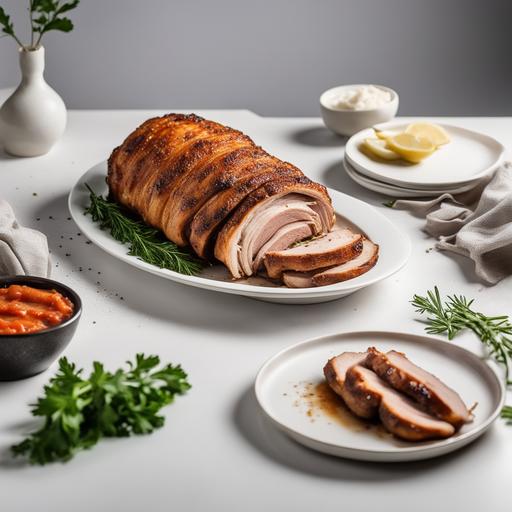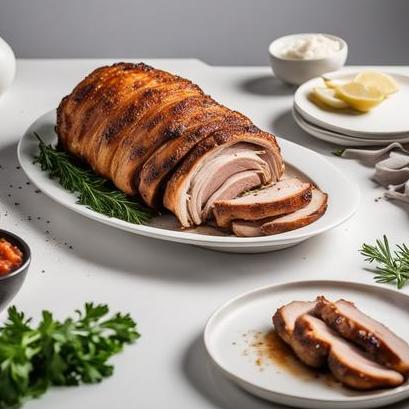
Porketta Oven Recipe: A Comprehensive Guide
Porketta is a flavorful and aromatic Italian pork roast that is roasted in the oven. The dish is made by stuffing a boneless pork shoulder with a variety of herbs and spices, then slow-roasting it in the oven for several hours until it becomes tender and juicy. In this comprehensive guide, we will delve deeper into the world of porketta by exploring the food science, culinary details, selection, cleaning, preparation, tips, variations, doneness checks and a yummy recipe.
Food Science
Porketta is a dish that takes advantage of both flavor and cooking science. Cooking science dictates that if you cook meat at low temperatures for a prolonged period, it will become tender and juicy. Porketta follows the same principle as it requires slow roasting to ensure the meat is cooked perfectly.
To add more depth to the dish, the classic porketta recipe incorporates a blend of herbs and spices into the meat, maximizing flavor and aroma. The aromatic herbs and spices are absorbed into the meat during the slow-roasting process, infusing it with a slight tangy flavor.
Culinary Details
Porketta is a popular dish served in many Italian households and restaurants. It is often served with regional side dishes, such as roasted potatoes, baked beans, or sliced bread. The dish is a perfect main course for a dinner party with friends and family.
Porketta is a versatile dish that can be cooked using several different techniques. Some of the most popular cooking methods include oven roasting, grilling, or slow cooking in a crockpot.
Selection

When selecting the pork shoulder for your porketta recipe, it is important to choose a boneless pork shoulder. The bone adds an extra layer of complexity to the dish, which can often be difficult to manage.
Look for a pork shoulder that is well-marbled with fat. This will ensure that the meat stays juicy and tender while cooking. Also, ensure that the pork shoulder has a nice, even shape to make stuffing much more manageable.
Cleaning
Before preparing your porketta recipe, it is important to clean the pork shoulder thoroughly. Start by rinsing it with cold water to remove any lingering debris or bone particles. Dry the pork shoulder using a clean cloth or paper towel.
If your recipe requires stuffing the pork shoulder, create the stuffing mix first but ensure that all herbs and spices are properly washed so as not to contaminate the meat.
Porketta Oven Recipe
Ingredients:
- 1 boneless pork shoulder
- 1 tablespoon fennel seeds
- 1 tablespoon dried thyme
- 1 tablespoon dried rosemary
- 1 tablespoon dried basil
- 1 tablespoon dried oregano
- 1 tablespoon kosher salt
- 1 teaspoon garlic powder
- 1 teaspoon black pepper
- 1/4 cup olive oil
- 1 onion, thinly sliced
- 3-4 garlic cloves, minced
Instructions:
- Preheat the oven to 300°F.
- Combine all the herbs and spices in a small bowl, then set aside.
- Cut a deep slit along the length of the pork shoulder to create a pocket for stuffing.
- Rub the spice blend all over the pork shoulder, ensuring that it is well coated.
- Pour olive oil over the pork and massage it in.
- Place the sliced onion and minced garlic inside the slit, stuffing it as much as possible.
- Tie the pork shoulder with kitchen twine to hold the stuffing inside.
- Place the pork shoulder on a roasting rack and air-exposed skin side up.
- Roast for about 4-5 hours or until the internal temperature reads 165°F.
- Let the pork rest for 10-15 minutes before slicing and serving.
Tips
- If possible, prepare the porketta roast a day ahead as it tastes better after resting for a day.
- Use a meat thermometer to check the internal temperature of the meat to avoid overcooking or undercooking.
- You can baste the pork shoulder every 30 minutes to ensure that it is flavorful and juicy.
- Remove the porketta roast from the oven when the internal temperature reaches between 160-165°F to allow for residual heat to bring it to 165°F without overcooking.
Variations

Porketta is a versatile dish that can be customized to suit your taste buds. Here are some variations that you can try:
- Substitute the herbs and spices with different seasoning blends, such as Italian seasoning or Cajun seasoning.
- Add vegetables like carrots, potatoes, and onions along with the garlic to the stuffing.
- Experiment with different cuts of meat such as pork belly or tenderloin.
Doneness Checks
The best way to determine if the porketta roast is cooked correctly is to use a meat thermometer. Insert the thermometer into the thickest part of the meat, being careful not to touch the stuffing. The internal temperature should read between 160-165°F.
Overcook
Overcooking your porketta roast will result in a dry and tough meat. It is essential to keep an eye on the internal temperature of the meat to avoid overcooking.
Undercook
Undercooking your porketta roast presents a health hazard as the meat may still harbor bacteria. To avoid this, use a meat thermometer to ensure that the internal temperature reaches between 160-165°F before serving.
Conclusion
In summary, porketta roasts are a delicious and aromatic dish that is perfect for entertaining large groups or small family dinners. The recipe is straightforward, but the flavor can be customized to suit your preference. Ensure that you follow the cleaning and cooking procedures and use a meat thermometer to ensure that the meat is cooked to perfection. Enjoy your porketta roast with a side of roasted vegetables or serve it as a sandwich for a more casual meal.
Sources
FAQS On Porketta Oven Recipe
What Is A Porketta Oven Recipe?
A porketta oven recipe refers to a cooking method used to prepare porketta, a popular Italian roast seasoned with various herbs and spices. This recipe involves slow roasting a pork roast in the oven until it becomes tender and succulent. It is a traditional dish from the region of Southern Italy and has gained popularity worldwide for its rich and flavorful taste.
How Do I Choose The Right Cut Of Pork For A Porketta Oven Recipe?
When selecting pork for a porketta oven recipe, it’s best to opt for a boneless pork shoulder or pork loin roast. These cuts are often well-marbled and have enough fat content to keep the roast moist during the long cooking process. It is recommended to buy a roast that weighs around 3 to 4 pounds, which allows for even cooking and easy handling.
What Herbs And Spices Are Typically Used In A Porketta Oven Recipe?
The key to a delicious porketta lies in the aromatic blend of herbs and spices used in its seasoning. Traditional recipes often include generous amounts of garlic, fennel seeds, rosemary, parsley, oregano, and black pepper. Other flavor enhancers like red pepper flakes, sage, and thyme can also be added to suit personal preferences. The combination of these herbs and spices creates a mouthwatering herb crust on the pork once cooked.
How Long Should I Cook A Porketta Roast In The Oven?
Cooking times for a porketta roast in the oven can vary depending on the size of the roast and the oven temperature being used. As a general guideline, it is recommended to cook at a lower temperature of around 325°F (165°C) for about 20-25 minutes per pound of meat. This slow-cooking method ensures a tender and juicy result. Using a meat thermometer to check the internal temperature and aiming for a reading of 145°F (63°C) will help ensure the roast is cooked to perfection.
Can I Prepare A Porketta Oven Recipe Ahead Of Time?
Absolutely! One of the great advantages of a porketta oven recipe is that it can be prepared ahead of time, making it an excellent option for gatherings and special occasions. The roast can be seasoned and refrigerated overnight to allow the flavors to intensify. When ready to cook, simply place the marinated roast in a preheated oven and let it slowly roast to perfection. The leftovers can be stored in the refrigerator for a few days and they often taste even better the next day.


